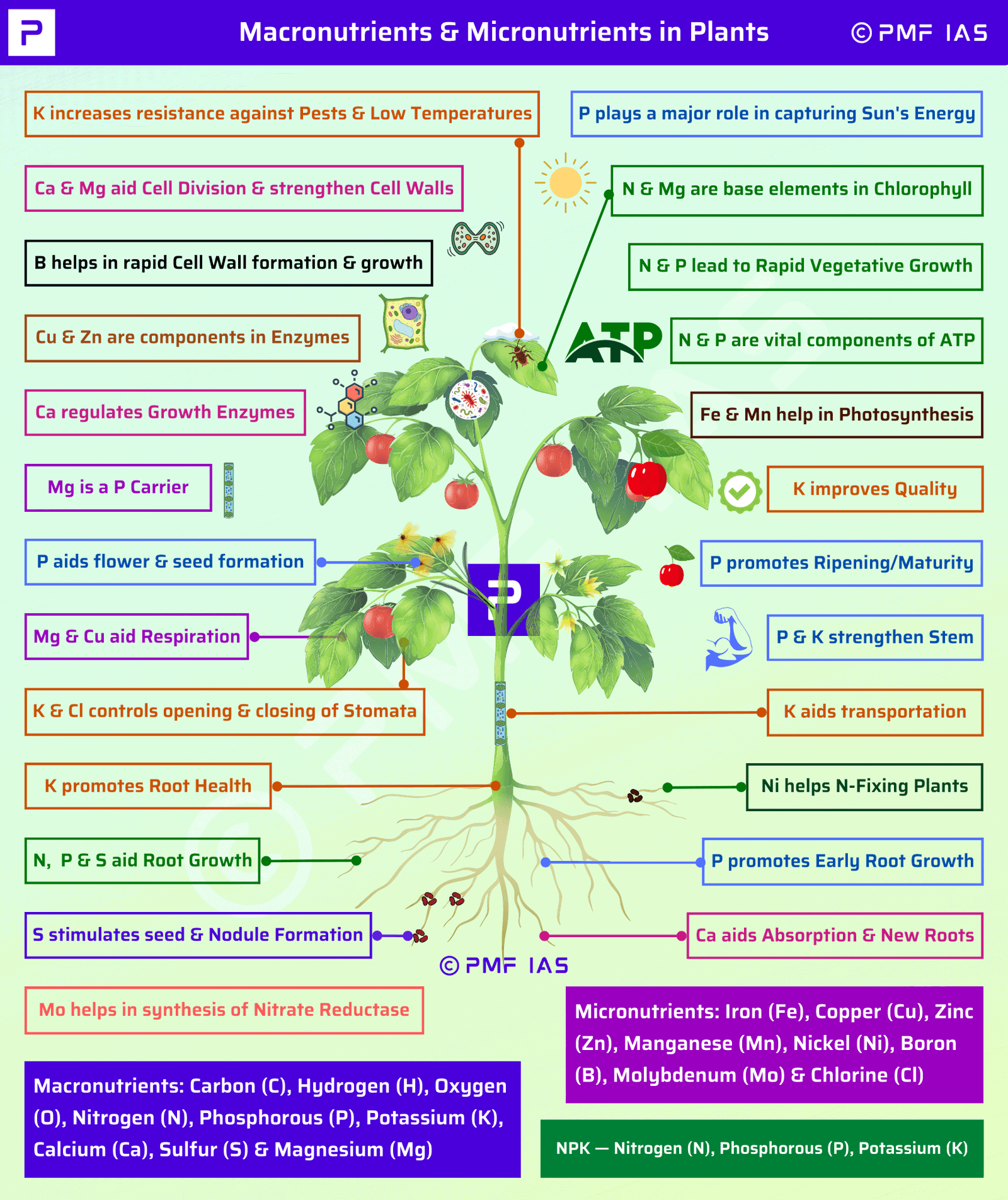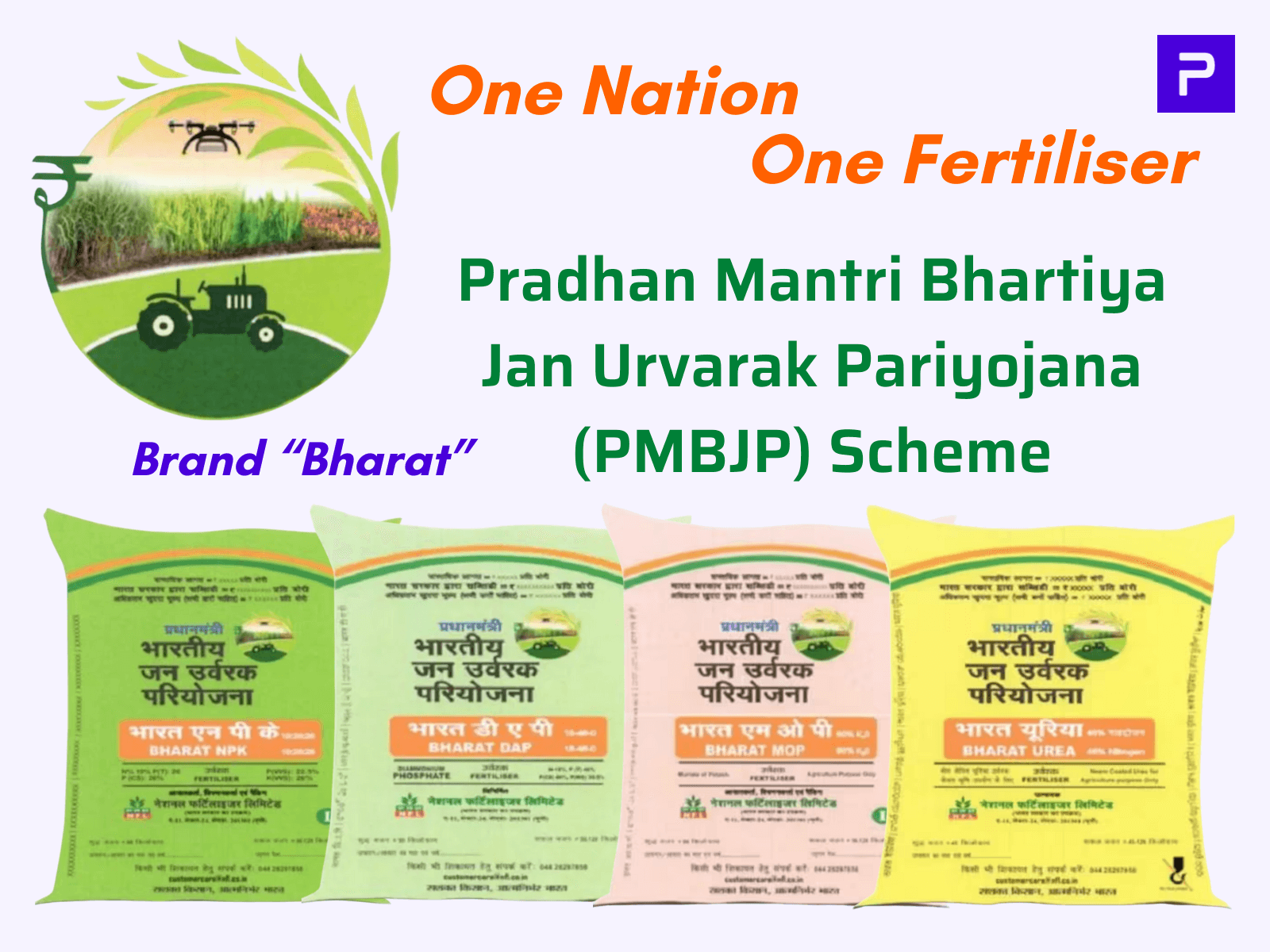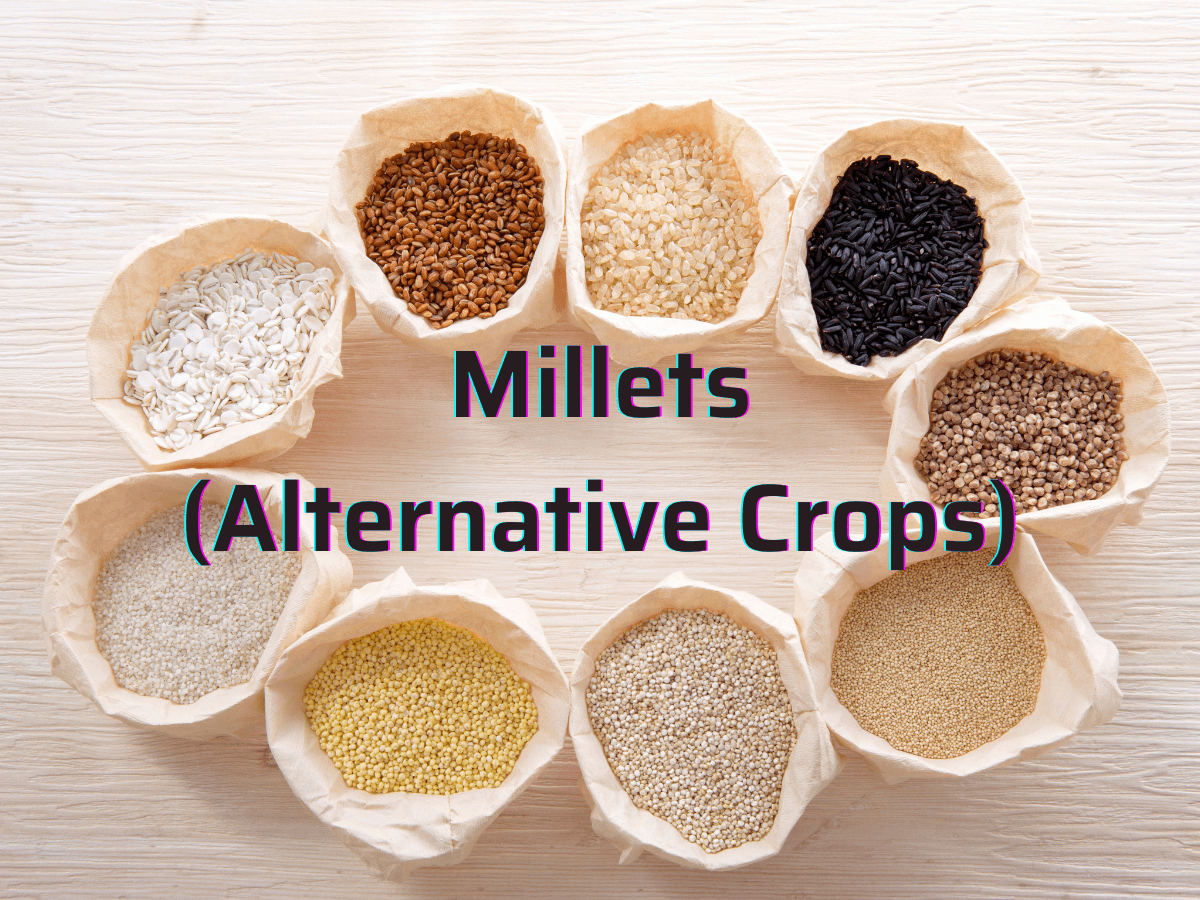
Macronutrients and Micronutrients for Plants
Subscribe to Never Miss an Important Update! Assured Discounts on New Products!
Must Join PMF IAS Telegram Channel & PMF IAS History Telegram Channel
- 17 elements act as essential plant nutrients. Nine of these are macronutrients — required by plants in large amounts, and the other eight are micronutrients — required in trace amounts.
- Macronutrients are generally present in plant tissues in significant amounts, while micronutrients constitute less than 1% of the dry weight of most plants.

Macronutrients for Plants
- Macronutrients (9): Carbon (C), Hydrogen (H), Oxygen (O), Nitrogen (N), Phosphorous (P), Potassium (K), Calcium (Ca), Sulfur (S), and Magnesium (Mg).
- Of the ten micronutrients, carbon, hydrogen and oxygen are obtained mainly from carbon dioxide (CO2) and water (H2O), while the others are absorbed from the soil as mineral nutrition.
- NPK — Nitrogen (N), Phosphorous (P) and Potassium (K) are the most significant macronutrients.
Carbon (C), Hydrogen (H) and Oxygen (O)
- Carbon and hydrogen are the major constituents of most biomolecules, including proteins, starches and cellulose. Photosynthesis converts carbon dioxide into carbohydrates. Hydrogen, obtained from water, is also used in photosynthesis. Plants require oxygen for cellular respiration during nighttime.
Nitrogen (N)
- Of NPK, nitrogen has received the maximum attention as it gets easily converted to soluble forms (nitrite) from various fertilisers.
Function of Nitrogen in Plants
- Nitrogen is a base element in all cells, proteins (chain of amino acids), hormones, and chlorophyll.
- It produces the most significant yield response in crop plants by promoting rapid vegetative growth and healthy green colour.
Sources of Nitrogen for Plants
- Organic matter in soil is rich in nitrogen. Plants take up nitrogen from the soil as NH4+ (ammonium/ammonium ions) and NO3– (nitrate). Some plants, such as Legumes, fix atmospheric nitrogen.
- Atmospheric nitrogen is used to make fertilisers like ammonium sulfate, ammonium nitrate and urea/carbamide (molecular formula: CH₄N₂O | chemical formula CO(NH2)2). When applied to soil, nitrogen is converted to an easily absorbable mineral form, nitrate.
- Urea has the highest nitrogen content of all solid nitrogenous fertilisers. Therefore, it has a low transportation cost per unit of nitrogen nutrients. Urea breaks down in the soil to give ammonium (NH4+).
Nitrogen Deficiency
- Nitrogen deficiency occurs when soil organisms use much nitrogen to break down harmful carbon sources in the soil. It leads to slow growth, small plant parts and leaves with less chlorophyll.
Phosphorus (P)
- Functions: Phosphorus plays a significant role in capturing and converting the sun’s energy (photosynthesis). Adenosine triphosphate (ATP), the energy unit of plants, is formed during photosynthesis.
- Phosphorus stimulates early root and plant growth and the nitrogen-fixing capacity of legumes. It hastens ripening/maturity, improves the quality of fruit/grain and strengthens the plant stalk and stem.
- Phosphorus deficiency leads to slow growth and weak and stunted plants.
- Source: Superphosphate (a mixture of calcium phosphate and calcium sulfate), made from rock phosphate and sulfuric acid. All manures contain phosphorus.
Potassium (K)
- Functions: Potassium increases resistance in plants against diseases, pest attacks, climate stresses, etc. It helps to form and move starch, sugars and oils in plants and improves fruit quality and quantity.
- It strengthens straw and root systems in cereals and reduces lodging. It increases the efficiency of the uptake of nutrients. It also controls the opening and closing of the leaf stomata.
- Plants deficient in potassium ‘lodge’ or bend over at ground level, making them difficult to harvest.
- Source: Potassium chloride (KCl/ — obtained from ancient dried lake deposits) and potassium sulphate (sulfate of potash/K2SO4 — found mixed with various other salts and ores).
Calcium (Ca)
- Functions: Calcium is essential for the growth of seeds, plant tissues, new roots, root hairs, etc.
- Sources: Lime, gypsum, dolomite and superphosphate.
Magnesium (Mg)
- Functions: Magnesium and nitrogen are base elements of chlorophyll. Magnesium is essential in activating enzymes involved in respiration, photosynthesis and nucleic acid synthesis. It serves as a carrier of phosphate compounds throughout the plant.
- Source: dolomite (calcium magnesium carbonate), magnesite (magnesium oxide), epsom salt (magnesium sulfate), etc.
Sulfur (S)
- Functions: Sulfur is a constituent of amino acids in plant proteins. It is responsible for odour compounds in plants. It stimulates root growth, seed formation and nodule formation.
- Source: Superphosphate, gypsum, elemental sulfur and sulfate of ammonia, soil organic matter, etc.
Micronutrients for Plants
- Micronutrients (8): Iron (Fe), Copper (Cu), Zinc (Zn), Manganese (Mn), Nickel (Ni), Boron (B), Molybdenum (Mo) and Chlorine (Cl). Most of them occur as trace elements in soil
|
Micronutrient |
Function |
|
Iron (Fe) |
Constituent of many compounds that regulate and promote growth and development. It is essential for the formation of chlorophyll and the synthesis of proteins. |
|
Manganese (Mn) |
Helps in photosynthesis and plant growth. |
|
Copper (Cu) |
An essential constituent of enzymes in plants. It also regulates respiratory activities. |
|
Zinc (Zn) |
Helps in the production of hormones responsible for stem and leaf expansion. |
|
Boron (B) |
Helps with the formation of cell walls in rapidly growing tissue. Deficiency reduces calcium uptake and inhibits the plant’s ability to use it. |
|
Molybdenum (Mo) |
Required for the synthesis of the enzyme nitrate reductase (reduces nitrate (NO3−) to nitrite (NO2−)), which helps N-fixing soil bacteria in legumes. |
|
Nickel (Ni) |
Required in small amounts for N-fixing plant species. Without nickel, toxic levels of urea can accumulate within the tissues. |
|
Chlorine (Cl) |
It helps in plant growth and development, osmotic and stomatal regulation and disease resistance. |














Twitter:
@Ratnakant Dixit.